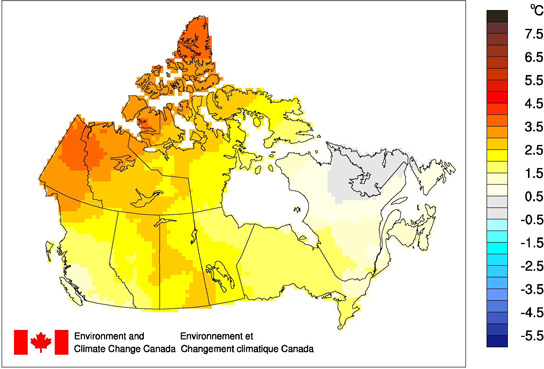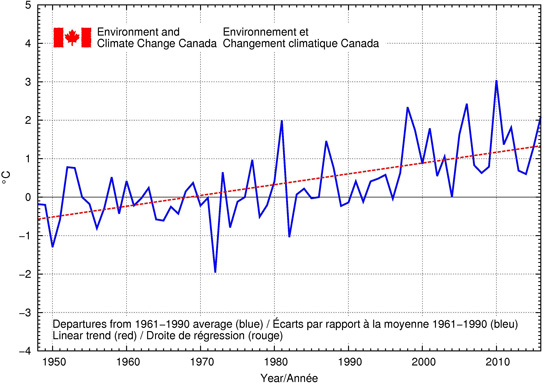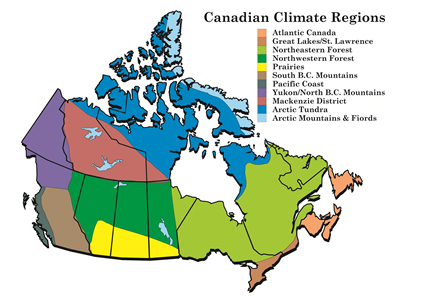Annual 2016: Climate Trends and Variations Bulletin
PDF format [334 KB]
This bulletin summarizes recent climate data and presents it in a historical context. It first examines the national average temperature for the season or year, and then highlights interesting regional temperature information. Precipitation is examined in the same manner.
National temperature
The national average temperature for the year 2016 was 2.1°C above the baseline average (defined as the mean over the 1961-1990 reference period), based on preliminary data, which is the fourth warmest observed since nationwide recording began in 1948. The warmest year occurred in 2010, when the national average temperature was 3°C above the baseline average. The coldest year occurred in 1972, when the national average temperature was 2°C below the baseline average. The temperature departures map for the year 2016 (below) shows that most of the Yukon, northern Northwest Territories and northwestern Nunavut experienced temperatures more than 3°C above the baseline average. Temperatures 1.0°C above the baseline average were found in the rest of the country with the exception of a small region in northeastern Quebec and Labrador where the temperature was near average.

Long description
The temperature departures map for the year 2016 shows that most of the Yukon, northern Northwest Territories and northwestern Nunavut experienced temperatures more than 3°C above the baseline average. Temperatures 1.0°C above the baseline average were found in the rest of the country with the exception of a small region in northeastern Quebec and Labrador where the temperature was near average.
The time series graph (below) shows that, when averaged across the country, annual temperatures have fluctuated from year to year over the period 1948-2016. The linear trend indicates that annual temperatures averaged across the nation have warmed by 1.7°C over the past 69 years.

Long description
The time series graph shows that, when averaged across the country, annual temperatures have fluctuated from year to year over the period 1948-2016. The linear trend indicates that annual temperatures averaged across the nation have warmed by 1.7°C over the past 69 years.
Regional temperature
When examined on a regional basis, average annual temperatures for 2016 were among the 10 warmest on record since 1948 for nine of the eleven climate regions: the Yukon/North B.C. Mountains (warmest at 3.1°C above average), the Prairies (2nd warmest at 2.3°C above average), the South B.C. Mountains (2ndwarmest at 1.7°C above average), the Pacific Coast (2nd warmest at 1.5°C above average), the Arctic Mountains and Fiords (3rd warmest at 2.7°C above average), the Northwestern Forest (3rd warmest at 2.2°C above average), the Mackenzie District (4th warmest at 2.8°C above average), the Arctic Tundra (4th warmest at 2.5°C above average), the Great Lakes/St. Lawrence (7th warmest at 1.5°C above average). None of the eleven climate regions experienced an average annual temperature for 2016 that ranked among the 10 coldest since 1948. All eleven climate regions exhibit positive trends in annual temperatures over the 69 years of record. The strongest trend is observed in the Mackenzie District region (2.7°C) while the weakest trend (0.7°C) is found in the Atlantic Canada region. A table listing the regional and national temperature departures and rankings from 1948 to 2016 and a table that summarizes regional and national trends and extremes are available on request to ec.btvc-ctvb.ec@canada.ca.

Long description
A map that shows the Canadian Climate Regions: Atlantic Canada, Great Lakes/St. Lawrence Lowlands, Northeastern Forest, Northwestern Forest, Prairies, South British Columbia Mountains, Pacific Coast, North British Columbia Mountains/Yukon, Mackenzie District, Arctic Tundra, Arctic Mountains and Fiords.
National precipitation
The national average precipitation for the year 2016 was 4.9% above the baseline average, based on preliminary data, making it the 16th wettest year since nationwide recording began in 1948. The wettest year was 2005 (15.6% above the baseline average) and the driest year was 1956 (12.2% below the baseline average). The precipitation percent departure map for the year 2016 (below) shows that conditions were wetter-than-average in the southern Saskatchewan, northeastern Saskatchewan, and northern Manitoba. Some small regions in northern B.C., southern Yukon, northwestern Quebec and Baffin Island show slightly drier-than-average conditions.

Long description
The precipitation percent departure map for the year 2016 shows that conditions were wetter-than-average in the southern Saskatchewan, northeastern Saskatchewan, and northern Manitoba. Some small regions in northern B.C., southern Yukon, northwestern Quebec and Baffin Island show slightly drier-than-average conditions.
It should be noted that "average" precipitation in northern Canada is generally much less than it is in southern Canada, and hence a percent departure in the north represents much less precipitation than the same percentage in the south. The national precipitations rankings are therefore often skewed by the northern departures and do not necessarily represent rankings for the volume of water falling on the country.
The precipitation percent departures graph (below) shows that, when averaged across the nation, annual precipitation amounts have tended to be wetter than the 1961-1990 average since the beginning of the 1970s.

Long description
The precipitation percent departures graph shows that, when averaged across the nation, annual precipitation amounts have tended to be wetter than the 1961-1990 average since the beginning of the 1970s.
Regional precipitation
Annual precipitation for 2016 was among the 10 wettest recorded since 1948 in two of the eleven climate regions: the Northwestern Forest (2nd wettest at 17.9% above average); and the Prairies (6th wettest at 20.6% above average). Annual precipitation for 2016 was not amongst the 10 driest years recorded since 1948 in any of the eleven climate regions. A table listing the regional and national precipitation departures and rankings from 1948 to 2016 and a table that summarizes regional and national extremes are available on request to ec.btvc-ctvb.ec@canada.ca.